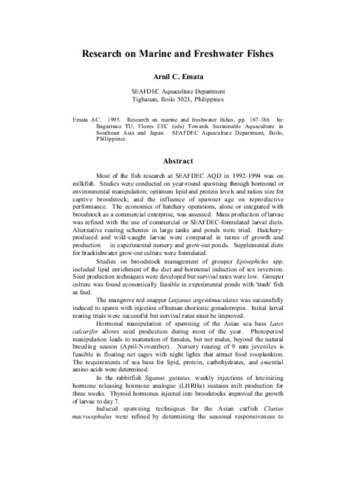Plasma osmolality and chloride regulation in the sea bass Lates calcarifer
- Global styles
- MLA
- Vancouver
- Elsevier - Harvard
- APA
- Help

View/Open
Date
1996Author
Page views
1,378ASFA keyword
AGROVOC keyword
Taxonomic term
Metadata
Show full item recordShare
Abstract
Seawater-adapted sea bass (Lates calcarifer) subadults and fingerlings were abruptly transferred to fresh water and freshwater-adapted subadults and fingerlings to sea water. To follow the responses of plasma osmolality and chloride concentration, blood samples were taken before and at intervals after transfer. Changes in plasma osmolality and chloride showed a pattern of initial crisis when osmolality and chloride levels deviated significantly from pre-transfer levels. The initial crisis was followed by a regulatory phase when these values returned to almost pre-transfer levels. Subadults transferred to fresh water had a regulatory phase (or the ability to return plasma osmolality and chloride to near normal levels) starting at Day 4 after transfer while fingerlings transferred to fresh water had a much earlier regulatory phase, starting at Day 1. Subadults transferred to sea water had stable plasma osmolality and chloride levels at Day 2 while fingerlings transferred to sea water regulatory phase commencing at Day 1.
Suggested Citation
Almendras, J. M. E. (1996). Plasma osmolality and chloride regulation in the sea bass Lates calcarifer. The Israeli Journal of Aquaculture-Bamidgeh , 48(1), 28-34. http://hdl.handle.net/10862/1549
Type
ArticleISSN
0792-156XCollections
- Journal Articles [1247]
Related items
Showing items related by title, author, creator and subject.
-
Research on marine and freshwater fishes
Emata, Arnil C. (Aquaculture Department, Southeast Asian Fisheries Development Center, 1995)Most of the fish research at SEAFDEC AQD in 1992-1994 was on milkfish. Studies were conducted on year-round spawning through hormonal or environmental manipulation; optimum lipid and protein levels and ration size for ... -
Proceedings of the Seminar-Workshop on Aquaculture Development in Southeast Asia and Prospects for Seafarming and Searanching, 19-23 August 1991, Iloilo City, Philippines
Lacanilao, F.; Coloso, Relicardo M.; Quinitio, Gerald F. (Aquaculture Department, Southeast Asian Fisheries Development Center, 1994)Documents the presentations at ADSEA '91, the 2nd Seminar-Workshop on Aquaculture Development in Southeast Asia. ADSEA '91 includes reviews of the status of the researches conducted by Southeast Asian Fisheries Development ... -
Nursery and grow-out culture of high-value fish species in sea cages
Gaitan, Albert G.; Toledo, Joebert D. (Aquaculture Department, Southeast Asian Fisheries Development Center, 2009)





